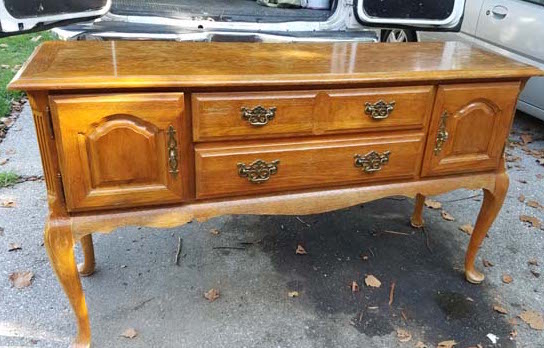Before & After Buffet Project
Good JuJu
While recently shopping for treasures, I spied a lovely vintage Stanley buffet at a sale. Queen Anne legs, killer hardware and LOTS of storage -- what a peach! However, the original finish was badly sun damaged and neglected. This poor thing definitely needed some TLC.
Now for the perennial question: Should I stain or paint? That's probably one of the hardest choices for furniture DIY’ers to make. If you think about it, there really is no 'wrong' answer. It's your piece, and you can do with it what you wish. If you don't like how it turns out, try something new. The Furniture Police are not going to swoop down and issue a citation for 'improper paint application.' Still, it can be daunting to put that first brush-full of paint on the as-yet-unpainted wood. I certainly had those misgivings the first time I painted a piece of furniture. But once you give yourself permission, and realize that there are no mistakes you can't undo, then it's full steam ahead.
After mulling it over for a few days, I decided that a buffet of this design and quality deserved a clean, classic finish. Since it's going to be for sale, I decided upon a beautiful, black paint. While I've used chalk paint in the past, I have yet to find a black chalk paint that gives me the deep, dark color I desire -- most black chalk paints look ashy to me. So, as I do for all my black furniture, I went with a Valspar Signature paint in my favorite black to date -- 'Cracked Pepper.' It's not a pure black, but has just enough grey in it to keep things interesting.
Painting tip: After much trial and error, I've found that painting with a matte or flat paint is best. It's easier to apply and dries faster because it contains less latex. Since I'll be applying multiple layers of poly, a satin or semi-gloss paint is really unnecessary.
I typically try to avoid painting hardware, so off came the drawer and door pulls AND the door hinges. The top and sides were especially sun damaged, with the finish worn in 'ridges.' So I broke out the orbital sander and 80 grit sandpaper. Any unsanded areas were cleaned with a liquid sandpaper/deglosser product. Forty-five minutes later, I had a smooth, paintable finish.
When painting furniture, I'm a firm believer in multiple, THIN coats of paint. This piece took 3 coats, but since I used flat paint (which dries quickly), I was able to get all the painting done in just two days. I chose to do some 'light' distressing, as buyers like it and... well ... it just looks good. Three coats of Minwax PolyCrylic finished the job. With the hardware reinstalled and the piece re-assembled, I'd say this beauty is ready for the next First Friday at Good Ju Ju!

